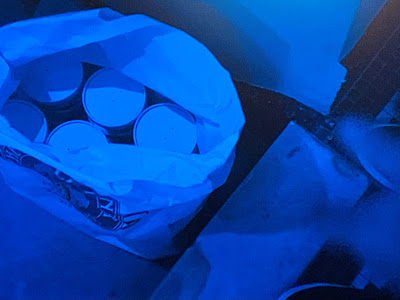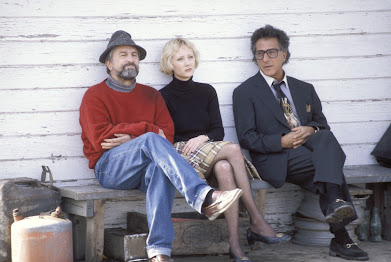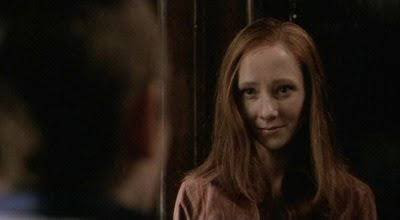Recently the official Twitter handle of the Toronto International Film Festival asked people for their favorite dance sequence in a film, getting the ball to their query rolling with a GIF of Greta Gerwig as Frances Halladay in “Frances Ha” (2012) dancing down the monochrome NYC sidewalk to David Bowie’s “Modern Love.” Of course, that scene is an homage to Denis Lavant doing the exact same thing to the exact same song in Leos Carax’s “Mauvais Song” (1986) which is not in any way meant to rule Greta’s cover version out of order but to suggest how so often in cinema what we love right now is, in essence, something that has probably already happened. That’s why when it comes to the best dance sequences in movies it’s hard to look much further than, like, you know, Gene Kelly in “Singing in the Rain” (1952), or Gregory Hines and Mikhail Baryshnikov going Beast Mode for a few minutes in “White Nights” (1985). The latter, though, just fostered some flimsy narrative excuses to get those two dudes to dance and is why, if push came to shove, I’d cite Ginger and Fred’s “Isn’t This a Lovely Day (To Be Caught in the Rain)” from “Top Hat” (1935) where Rogers and Astaire seem to walk on air even more than that time Fred literally danced on a ceiling while simultaneously advancing the character and the plot. Plus, it cuts straight to the heart of what makes a rainy day so magical. Sigh. Let’s watch it, whaddaya say?
But. TIFF’s prompt was not for the Best Dance Sequence in a movie. No, it asked for Favorite, and that’s a whole different ballgame, and a more interesting one to me. After all, I’m a guy who likes to dance but can’t dance. I’m Alec Baldwin in “It’s Complicated” (2009) who in his dance sequence with Meryl Streep doesn’t really dance at all but just sort of effects dancing by bobbing up and down. I’m Kevin James in “Hitch” (2005) except it’s really as bad as Will Smith thinks it is. I’m the dufus dancing during the woeful Bob Marley dorm room singalong in “Kicking and Screaming” (1995). Mostly, though, I’m Ed Harris in last year’s “The Lost Daughter” – last year’s recipient of the “Isn’t It a Lovely Day (To Be Caught in the Rain)” Award – when his character gives up trying to dance to “Livin’ on a Prayer” and just starts enthusiastically jumping up and down; I excel at enthusiastically jumping up and down. And this is why despite the euphoria of climactic movie dance scenes like “Flashdance” (1983) or “Strictly Ballroom” (1992), I am more drawn to the culminating dance number in “Silver Linings Playbook” (2012) in which choreographer Mandy Moore (not that one) did a bang-up job devising a routine that would seem wholly credible for two amateur dancers (in the movie and in real life) and uplifting in its own way nonetheless, an exultation of being average. A la médiocrité !
This is also why people who know Cinema Romantico best (too well) will not be surprised that Frank Drebin (Leslie Nielsen) and Jane Spencer’s (Priscilla Presley) Dance of the God-Knows-What in “The Naked Gun 2 ½” (1991), as if Steve Martin and Gilda Radner had choreographed “Shall We Dance” (1937), holds a special place in my heart. When the dance really ramps up, however, it goes to a long shot, out of necessity more than trying in any real way to disguise its dance doubles. That Nielsen and Presley needed doubles is no great flaw – nay, no flaw at all – but it’s also why I love the dance in Yorgo Lanthimos’s “The Favourite” (2018) just a little bit more, the one that improbably filters the spirit of “The Naked Gun 2 ½” Dance of the God-Knows-What through a Baroque sensibility. Because Rachel Weisz and Joe Alwyn as Lady Sarah and Baron Masham perform their absolute nuttery with straight faces all on their own. I’m not making a Top 5 here, but this would be on it.
I do not, however, want people to think I merely respond to the substandard or the ridiculous when evaluating and/or enjoying cinematic cuttings of the rug. Far from it. (Perhaps this is also where I should confess my knowledge of Bollywood dance numbers is virtually non-existent.) My high school girlfriend and I showed the German foreign exchange student “Saturday Night Fever” (1977) because...John Travolta and Karen Lee Gorney dancing to “More Than a Woman” was an American cultural touchstone? It also showed their characters losing it so much in the music that they just stop dancing and kiss, the scintillating red neon of most of the scene giving way to a blue that’s less icy than cool, as if all they can think, to quote Alabama Worley, is “you’re so cool.” It’s a personification of how so often dancing in the movies isn’t dancing. The kidz today are always talking about vibes and, buddy, lemme tell ya, Michael Mann rendered the key relationship of “Miami Vice” (2006) between Colin Farrell and Gong Li as nothing but vibes, “Sexy,” as the five-time Pulitzer finalist Manohla Dargis concisely put it for the most recent episode of the Miami Nice podcast, “as fuck,” so sexy dancing to Emilio Estefan’s Latin pop cover of Mandy Moore’s (that one) “In My Pocket” that we the audience momentarily become like Naomie Harris and John Ortiz – voyeurs. Nothing is sexier, though, than Elvis and Ann-Margret call and response mating dances to “C’mon Everybody” in “Viva Las Vegas” (1964). She shakes and rattles and rolls like she’s been moonstruck and he receives her overtures by swaying his hips as only Elvis can before they take the stage together and she falls into his arms with some none-too-subtle shrieks emphasized on the soundtrack and then they collapse side-by-side on the stage looking for all the world like two people who just took a roll in the hay. If you tried to include this scene in a major motion picture now the prudes in charge would shut the production down and hose off the soundstage.
But while people dancing together is great, there is something just as spellbinding in people, to quote her Swedish highness Robyn, dancing on their own. Madonna might have gotten tired of dancing there in her room all by herself, but her acolyte Little Boots knows that even if you go to the club to dance, it’s best to wear your headphones, to dance to beat that’s in your head. I don’t know, some Atlantic writer would probably huffily chalk this up to our navel-gazing AirPods culture, but as far back as 1983 in northern Italy, as “Call Me By Your Name” goes to show, people were dancing by themselves. Yes, technically Oliver was dancing to “Love My Way” by The Psychedelic Furs with a woman…but not really. He’s in an emotional, mental, and physical space all by himself. I’d tell you to watch it again and provide the link, but Oliver was played by Armie Hammer, of course, and per the recent Treaty of Burbank I am legally unable to link to any videos of the Armie Hammer. But that’s no biggie! Who needs Oliver in Crema when you’ve got Chris Parker in the suburbs of Chicago?! Grandmaster Marty employed “Then He Kissed Me” by The Crystals to “Goodfellas” (1990) to demonstrate a burgeoning romantic harmony, but “Adventures in Babystting” (1987) deployed it as a solo, the ultimate manifestation of a teenager turning her room into a concert stage at Madison Square Garden in her mind, and, reader, Elisabeth Shue knocked it out of the park, leading to the rare forthright Cinema Romantico Shueroll.
Four years earlier, as it happens, in the insane, forgotten “Exposed” (1983), Natassja Kinski transformed the hardwood floor of her apartment into a dancefloor, shaking it out to Merry Clayton’s “It’s In His Kiss.” Unlike Shue’s dance, however, which is all teenage innocence, Kinski’s concludes with her sprawled on the floor. Sometimes even when you shake it off, you just end up with nothing left, spiritually as much as physically. No solo movie dance, though, compares to Rosie Perez’s in “Do the Right Thing” (1989). Because rather than placing her dance at the climax, or even in the middle, Spike Lee puts it right up front and in your face, mirroring the camera work, mirroring the accompanying Public Enemy anthem “Fight the Power,” mirroring Perez’s moves with improbably manage to harness P.E.’s potent, unsurpassable militancy, evoking dance as something more than sweaty release – that is, protest.
Perez’s dance was out on the street, not in the club, evoking the mise-en-scène of “Do the Right Thing,” that Bed-Stuy block her home as much as Kinski’s hardwood floor or Shue’s kitchen. And that’s how I tend to think of dancing, I suppose. The best dance parties tend to be at home. Not just the dance parties for one, mind you, but group dance parties too. The dance party scene of “House Party” (1990) was made up on the spot, according to star A.J. Johnson, and feels like it in the best way, capturing the joyful spontaneity of such moments. But then, I’m me, and me is basically Diedrich Bader in that episode of “The Fresh Prince of Bel-Air” where he sticks to the couch while the whole Banks family dance arounds him; he knows full well they’ve got more way rhythm than him and I’ve got no rhythm at all. I love that scene in “House Party” but as a white hipster dufus, I’m just a teensy bit more drawn to dance party scene in Aaron Katz’s momentous “Quiet City” (2007), the one where four twentysomethings drink a few beers and dance in someone’s Park Slope living room. Katz forgoes diegetic music, however, meaning we cannot hear the song to which the characters are dancing, opting to highlight the scene instead with Keegan DeWitt’s score, a splendid choice that heightens the effect, a lyrical commentary on how the at-home dance party makes you feel.
Again, though, like Little Boots wearing her headphones at the club, you can, if you so choose, carve that space out for yourself anywhere. And that finally brings us full circle. Because just as Brooklynite France Halladay dancing down the sidewalk homage a French movie, so, too, was the dance party in Brooklyn-set “Quiet City” something of a French movie homage, just as Mia Wallace and Vincent Vega twisting in Jack Rabbit’s Slims was something of a French movie homage, just as so many dance movie scenes are something of a French movie homage. That French movie I’m talking about is Jean-Luc Godard’s “Band of Outsiders” (1964). That band was portrayed by Anna Karina, Sami Frey, and Claude Brasseur, whom, sitting at a Parisian café, suddenly get up and dance. And keep dancing. And keep dancing. Unlike Katz, Godard prefers a diegetic approach, ensuring we can hear the noise of the café around them, putting into perspective how they lose it in the music. Yet even as they lose it, Godard eventually interrupts, in a manner of speaking, with a voiceover providing a quick overview of each character’s thoughts. In that way, “Band of Outsiders” presages Lady Gaga’s very first single where the verses are the thoughts in her head and the chorus – “Just Dance” – fumigates them.








































